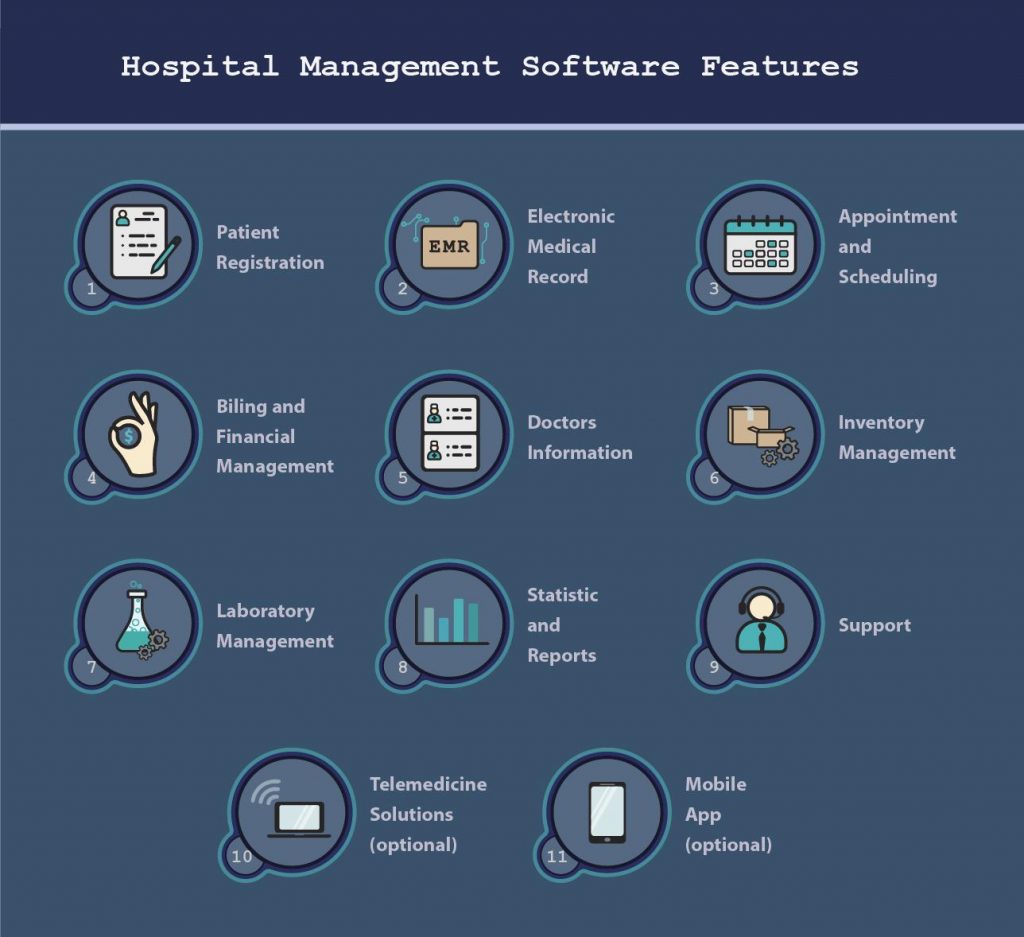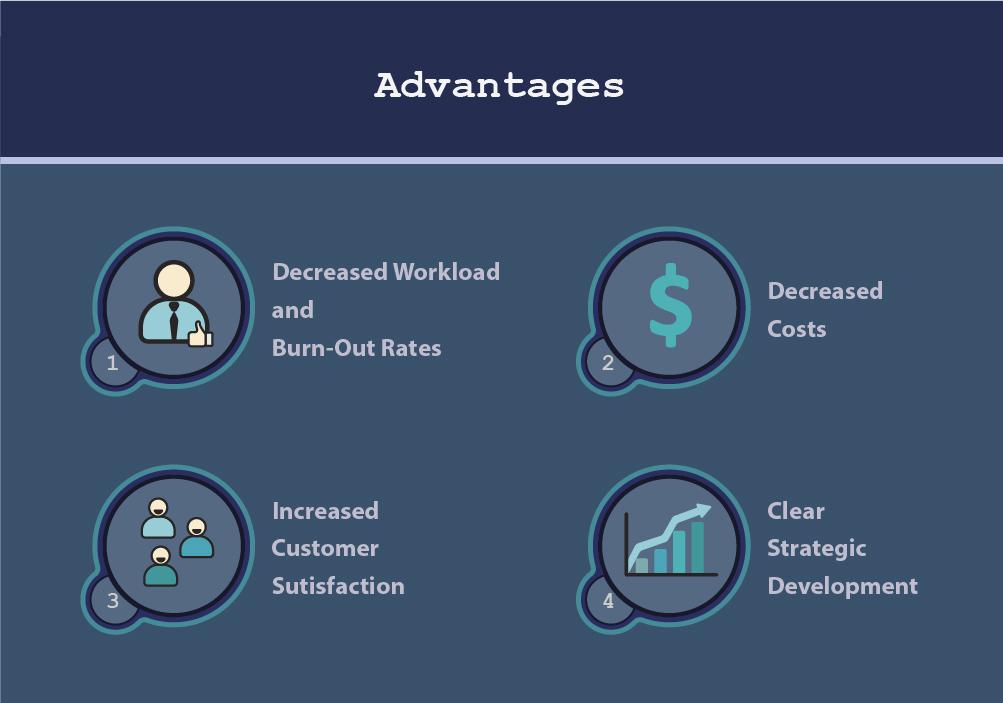Creating a hospital management system provides medical facilities with the required boost to deliver service to more people and give medical personnel more breathing room.
Development of a Hospital Management Software: Purposes, Advantages, Cost.
The standard of living and increased life expectancy the modern healthcare can grant are unprecedented. However, the efficiency of the industry is severely hindered by the operational crisis, omnipresent bureaucracy, and obsolete management practices that put too much strain on medical personnel. As a result, the price of healthcare services grows, the number of people who have access to affordable healthcare decreases while the quality of the services plummets as well due to employee exhaustion and an ineffective working environment.
Thus, there is a necessity, or even an ultimate goal, to boost healthcare establishments’ productivity in order to deliver the service to the maximum possible number of people who require it. Such responsibility lies within the hands of not only management and medical personnel but also politicians and software engineers. The latter can develop a reliable hospital management system that can address some of the mentioned issues and increase efficiency.

This article will guide you through the world of hospital management systems, describe their types and functionality, examine the advantages they grant and the costs of development.
The article’s contents:
1. Types of Hospital Management Systems
2. Hospital Management Software Features
3. Advantages of Implementing Clinic Management Software
4. How Much Does it Cost to Develop Hospital Management Software?
5. Final Thoughts
Types of Hospital Management Systems
To put it simply, the hospital management system software is software that automates routine management processes and stores all information required to run a medical establishment.
If you want to unite and provide easy access to information about personnel, patients, suppliers, billing, and statistics, you should design a hospital system software. In addition, the management system can have integrated telemedicine solutions.
Basically, with such a management system, a hospital’s employees have a multi-purpose digital tool that helps them to handle daily tasks with minimal effort.
Clinic management software varies in its complexity, scale, and functionality depending on a medical establishment’s requirements, size, and budget. Even though the functionality of hospital software can vary significantly from one establishment to another, the four basic types of clinic management systems can be defined.
They include
– Operational and tactical systems for easy classification and management of information
– Patient administrative systems for managing interaction with patients on an administrative level
– Subject-based systems, such as Electronic Medical Records (EMRs) or Electronic Health Records (EHRs)
– Task-based systems, which are associated with certain tasks, such as admissions/discharge systems.
– Billing systems for monitoring and managing finances
Of course, the hospital management system can combine different types of software or bits of functionality. There are no strict cannons regarding the creation of hospital software. A digital product for a clinic can be designed to be a perfect match for a specific company’s requirements and needs.
Hospital Management Software Features
As we established earlier, software for medical establishments can vary in types and functionality depending on the context. However, regardless of any given hospital’s needs, requirements, and approach to work, there are some universal features without which hospital management software would be pretty much useless.
The most prevalent must-have features that should be included if you are to build a hospital information management system are

1. Patient Registration and EHR/EMRs
First and foremost, management software should have hospital registration software to provide the possibility to register patients into the hospital’s system and file in all relevant information. Establishing a proper patient registration system software is the foundation upon which the rest of the patient-interaction system logic is built.
Electronic health records should contain all necessary patient information and be easily accessible and constantly updated with minimum effort.
2. Appointment and Scheduling
Patients should be able to book a visit. In addition, physicians and patients should have access to patients’ accounts in order to view and change appointment informationб if required. Finally, the system should notify about approaching appointments with alerts, emails, or SMS.
Such a system
1) Allows for scheduling and managing appointments
2) Provides a convenient feedback mechanism
3) Provides the possibility to notify patients via phone or mail
4) Automates patient check-in system
3. Billing and Financial Management
A hospital management system should have a hospital billing system that provides the possibility to manage and monitor finances and different financial operations including taxes, revenues, costs, and patient bills.
The medical software should also be able to automatically calculate the total costs for services a patient was provided with as well as track the patient’s financial history. Ideally, the prices are predetermined, so as soon as a patient books an appointment, he or she can view the final price for the service the patient requires.
In addition to the decreased workload and mitigation of human-factor errors, the automation of the financial and billing management grants also helps to better analyze the financial position of a medical establishment and make necessary corrections to the strategic course in order to increase efficiency.
4. Doctors Information
Ideally, medical software should have a section with information about physicians that provide their service at the establishment. The section should contain a list of the available doctors and their schedules as well as the experience, achievements, and expertise of the medical professionals.
People want to know as much as possible before visiting a hospital, so the more information there is about a medical establishment, the more likely people will visit it.
5. Inventory Management
In order to ensure that the supply of medical materials is steady and there are no sudden shortages of critical materials, proper inventory management is required. Well-crafted software can be an irreplaceable helper in this regard.
With the help of such software, employees can monitor the supply and calculate how many items are available and when the next restocking is required. In addition, inventory management can help monitor the expiration dates of the drugs.
6. Laboratory Management
Laboratory management is quite an essential part of every hospital management system because it allows for the faster retrieval of the laboratory analysis results. Proper software can quickly notify physicians and patients about the results of the analysis as well as provide easy access to all the lab information in one place.
The speed with which the doctors and patients receive the results of the analysis is often vital to the efficiency of the treatment and overall customer satisfaction.
7. Statistics and reports
Statistics and reports are not an essential and yet extremely helpful feature the hospital management system can have. Extensive statistics on finance, patients, and doctors’ information can be a source of invaluable insights that help the medical establishment develop. With well-tuned software, it is possible to create statistics and reports with just a few clicks of a mouse.
8. Support
If a healthcare establishment’s management software is complex, has a lot of different modules that should work in unison, and serves a lot of users, a support/helpdesk solution is pretty much mandatory. The support section of the healthcare management system should have all the tools necessary to help the support personnel handle different issues and requests from users as well as facilitate the proper functioning of the system and the integrity of the data.
9. Telemedicine solution
Telemedicine solution is a modern approach to healthcare that allows conducting virtual remote meetings with a physician via teleconferencing. It’s not suitable for all establishments, but some of them, which do not necessarily require a face-to-face meeting, could seriously benefit from this software. A bright example of an efficient telemedicine solution is a Full Circle Telepsychiatry KindGeek developed.
10. Mobile App for Customers and Employees
The absence of a mobile app that complements healthcare establishment software can be a severe competitive disadvantage as well as strategic misstep as mobile applications becoming a major point of connection between consumers and companies. A basic mobile app for hospital management could contain personal treatment calendars, schedules with dates available, information about doctors, the ability to book appointments, and
In addition, a mobile app can be used by employees to interact with a clinic management system in a more convenient way. With such an app, they will always have access to the software as far as their smartphones are with them.
Advantages of Implementing a Clinic Management Software
Even if a medical establishment has the best doctors, medical equipment, and resources, but its management processes are poorly optimized; the personnel is drowning in tons of paperwork, and employees are overworked and stressed due to bureaucracy and absence of smooth workflow; the healthcare facility would not function well and its patients would often be dissatisfied. This is where a well-crafted, relevant, and reliable clinic management software can make a huge difference.
There are a lot of advantages of implementing healthcare management software even with basic functionality.
They include:

1. Decreased Workload and Burn-Out Rates
Medical workers are prone to burn out considering the specifics of their work. Add to this previously reported, “time pressure, lack of control over work processes, role conflict, and poor relationships between groups and with leadership, and emotional intensity of clinical work.” No wonder, such a stressful environment detrimental to medical personnel’s well-being.
Furthermore, reports indicate that healthcare employees spend up to half of their working time dealing with paperwork. It’s a counterproductive and taxing process that could be made less straining by implementing relevant software.
In addition, another study claimed that nurses spend approximately 7% of their time searching for necessary supplies. It occurs because often there is not a sure way to inform nurses about the fact that the drug or equipment has arrived or has finished. Therefore, they have to check everything manually walking to another section of the establishment. Relevant software that automates inventory management can significantly lower this amount of time.
Developing healthcare management can target a lot of the issues mentioned above as the primary aim of the software is to automate processes and decrease unnecessary workload.
2. Decreased Costs
Hospital administrative costs, “including costs for submitting and processing claims,” can sum up to 25% of total spending. Add to this insurance claims costs, and you have a significant amount of spending induced by bureaucracy.
The process of claims procession requires a lot of repetitive manual work, A proper healthcare management system can significantly decrease the costs of this bureaucratic process by automating it. In addition, management software can streamline workflow and optimize other areas of managing a medical facility as well.
For instance, patient registration, inventory, and laboratory management can be quite taxing procedures if not automated. As a result of proper digitization, a clinic needs fewer working hours to do the same amount of work.
3. Increased Customer Satisfaction
Streamlined patient registration, ability to book appointments, monitor schedules, quickly receive lab analysis results in a convenient format, chose doctors — a patient can do it all using a computer or a mobile device if a hospital has a software system.
Moreover, the billing process is transparent and intuitive while all information about the patient’s journey is conveniently stored in one place and can be reviewed. In addition, all processes take less time to perform than in the medical facilities that did not implement software solutions. As a result, customer interaction with a hospital is a smooth and positive experience.
Finally, patients will interact with less stressed and more positive employees. As a result, the patients will lead to better service, have better impressions have about the clinic, and will be more willing to use the hospital’s services again.
4. Clearer Strategic Development
With a decent hospital management system in place, it is much easier to see the full picture and has full control over the internal processes. As a result, the management has all the tools necessary to make and implement strategic decisions to further the productivity and efficiency of the healthcare establishment. Otherwise, it is difficult to navigate in the haze of bureaucratic fuss and quickly implement necessary strategic corrections.
Custom Healthcare Solution
However, there is quite a significant difference between implementing a one-for-everyone management software, and healthcare systems that were developed for a particular establishment with all its needs in mind.
There are ready-to-use healthcare software solutions for sale, and clinics that don’t use any management software can seriously benefit from it. However, those universal healthcare systems would not be as beneficial for the company as custom software would. An average solution that was created for a mass-market may have basic features, but it did not consider the specifics of a particular hospital.
There is always a certain compromise with for-sale healthcare management software. You can find the most suitable candidate but it still will lack in certain areas. Besides, with typical subscription models, software management systems propose you have to pay more as your establishment grows. With a custom solution developed specifically for your establishment, you have to pay only once and have a healthcare management system that is just perfect.
It’s like buying a suit in a shop or ordering a suit tailored specifically for you. The difference in price can be quite tangible but the final results are not even comparable. A custom-tailored suit sits just perfectly and does not strain your motions.
How Much Does It Cost to Develop a Hospital Management Software?
The cost of creating medical software depends on a variety of different factors, which include
– The complexity of the system
– The number of the required modules
– The platform the system will run on
– Time of development
– A software development company’s rates
– The necessity to use Business Analysis expertise
Therefore, it is difficult to overline even the average price for designing an average clinic management software. However, if there is an accurate description of a hospital management system’s functionality, experienced developers can provide you with estimates of the costs after thorough analysis. Overall, estimation is a meticulous process, and its accuracy depends on the extensiveness of the provided information.
The most certain way of figuring out how much will development of hospital management software cost is to conduct a discovery phase. (You can read more about the pros of conducting a discovery phase here). The discovery phase will not only provide you with the most accurate estimates of future costs but will deliver you, depending on the chosen package,
– product concept from Product Manager
– prototypes from Business Analyst
– a visual concept from UI/UX Designer
– architecture concept from System Architect
– estimates of development costs
As a result, you will know the price and have accurate blueprints required to create hospital management system software, which could be used to build a custom software solution for a medical facility.
Final Thoughts
Developing a Hospital Management System is a great way of boosting medical facility’s productivity, decreasing workload and burn-our rates, streamlining workflow, and raising customer satisfaction rates.
Clinic management systems come in great variety with different levels of complexity and features depending on an establishment’s peculiarities, requirements, expertise, and approach to work. Even though there are software management systems for sale that are ready for commercial use, they do not grant the same level of customization specifically designed software does.
Building a custom hospital management system requires extensive development and business expertise as well as knowledge of the unique regulatory environment of the healthcare industry. KindGeek, as a full-cycle software development company with Business Analysis competence, has the required skills as well as experience developing software for the industry.
We would be happy to build you a healthcare management system that will elevate your medical facility’s productiveness to the next level.
If you think we can help you, contact us.




